Hummingbird nests are some of nature’s most amazing tiny creations. These small birds build homes that are perfectly sized for their delicate eggs and babies. You’ll discover that hummingbird nests are marvels of engineering, constructed with materials like spider silk and plant fibers that create stretchy, camouflaged homes.
The way hummingbirds build and care for their nests shows incredible skill, smarts, and dedication. Female hummingbirds work alone to create these tiny cup-shaped structures. You’ll learn about the clever ways these birds hide their nests and how they choose the perfect spots to keep their young safe.
Hummingbird Nests are Smaller Than You Think
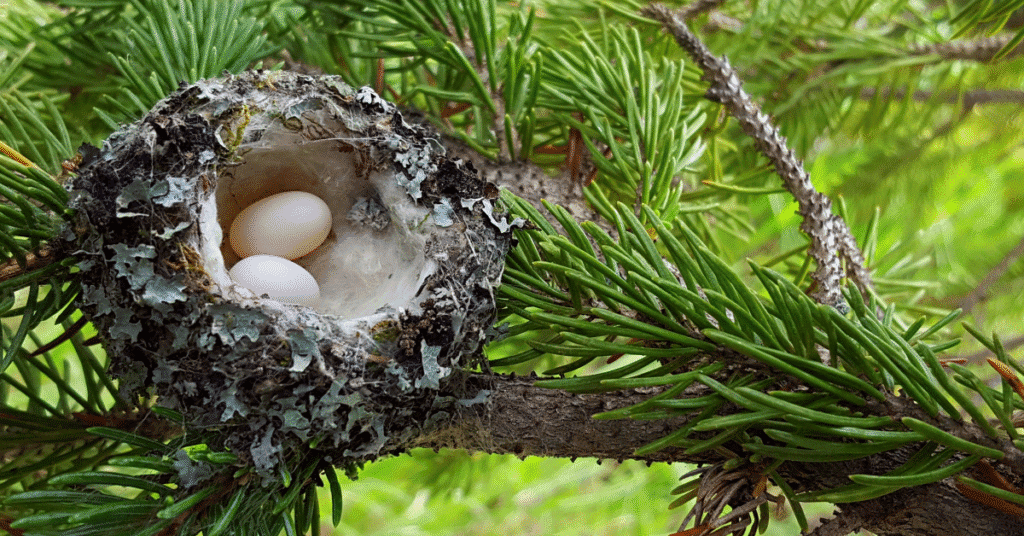
If you’ve ever seen a hummingbird nest, you know how tiny they are. These small homes are usually only 1.5 to 2 inches wide.
That’s about the size of a large walnut shell or ping pong ball. You could easily hold one in the palm of your hand.
The small size makes perfect sense when you think about it. Hummingbirds are some of the smallest birds in the world. Their babies are incredibly tiny, too.
These mini nests are just the right size for hummingbird eggs. Each egg is only about the size of a small jellybean. Even the Giant Hummingbird has a small nest!
You might walk right past a hummingbird nest without noticing it. The tiny size helps keep the nest hidden from predators.
Mother hummingbirds build these small nests to fit their bodies perfectly. When she sits on the nest, she covers it completely.
The nest needs to be small enough to stay warm but big enough for the babies to grow. As the chicks grow bigger, the nest expands slightly to provide them with more room.
Three Main Materials Work Together
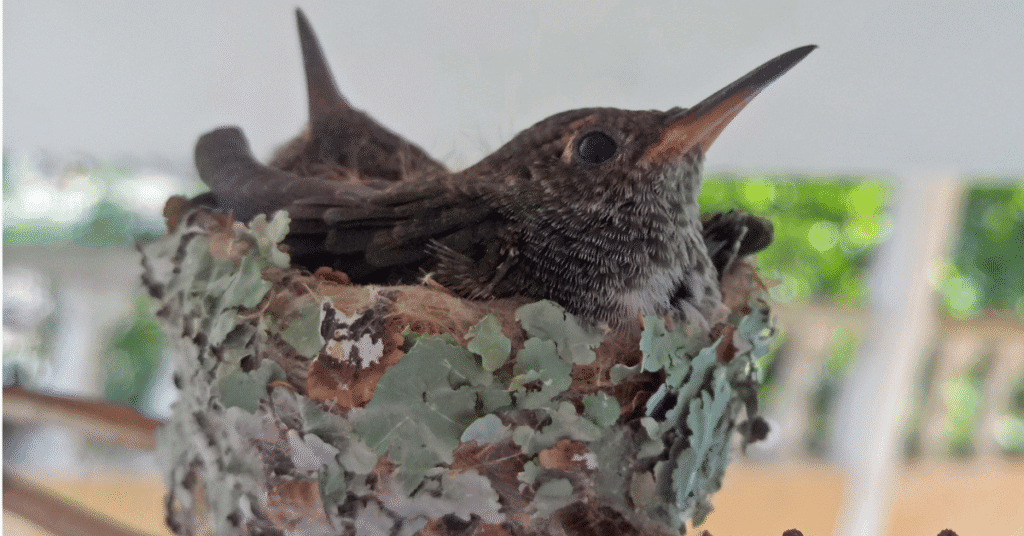
When you watch a hummingbird build her nest, you’ll see her gather three main materials. She collects soft plant fibers like cotton from seeds and downy material from flowers.
Spider silk plays a key role in nest construction. You might notice the female hummingbird carefully collecting strands of silk from spider webs. This silk acts like natural glue and elastic bands.
The spider silk helps bind all the materials together. It also gives the nest its stretchy quality, which is important as baby hummingbirds grow.
You’ll often see moss woven into hummingbird nests, too. The moss provides extra insulation and camouflage. It helps the tiny nest blend in with tree branches.
These three materials work together perfectly. The plant fibers create a soft base for the eggs. The spider silk holds everything in place and allows the nest to expand.
Then the moss adds protection from the weather and predators. Together, all 3 make a home that’s both cozy and strong enough to protect the babies until they’re ready to fly.
Camouflage Is Key When Talking about Hummingbird Nests

When you look for hummingbird nests, you might walk right past them without noticing. These tiny birds are masters at hiding their homes.
Hummingbirds collect small pieces of lichen from tree bark and rocks. They also gather bits of moss from damp areas.
The birds carefully stick these materials to the outside of their nests. They use spider webs and plant fibers to hold everything in place.
This natural decoration makes the nest look like part of the tree branch. You would need to look very closely to spot it.
The lichen and moss match the colors of the surrounding area perfectly. Green moss blends in with leafy areas, while gray lichen matches the texture of tree bark.
This camouflage keeps the nest safe from predators. Hawks, snakes, and other animals struggle to locate the hidden eggs and babies.
Even when you know where a nest is, the camouflage can fool you. The materials blend so well that the nest seems to disappear into the background.
Most Hummingbird Nests are Cup-shaped
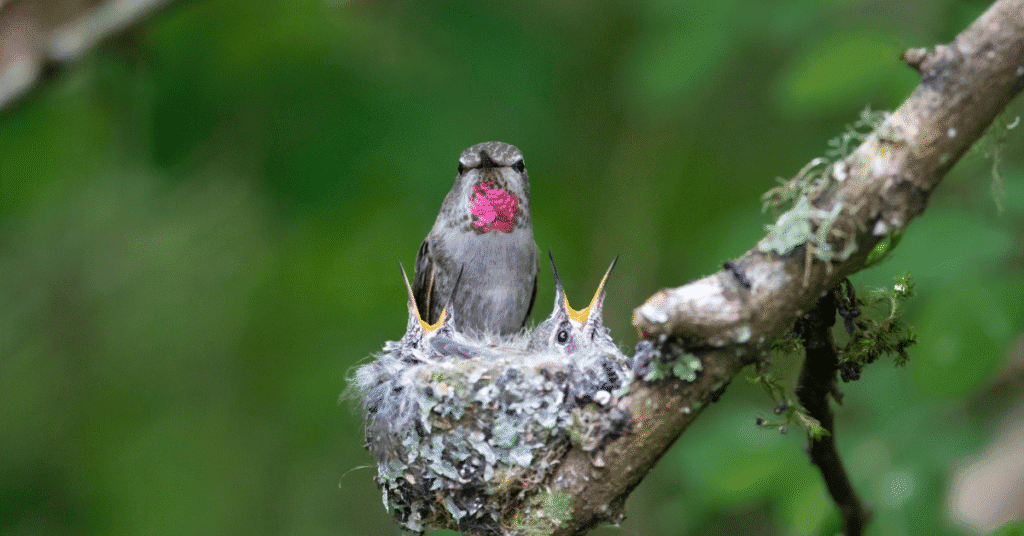
You’ll find most hummingbird nests have a simple cup shape. This design works well for holding eggs and baby birds safely.
Female hummingbirds usually build their nests on tree branches. They often pick spots where a branch forks from the main trunk. The forked branch gives the nest good support.
Shrubs are another favorite nesting spot. The small branches provide the right size base for tiny hummingbird nests.
You might be surprised to learn that some nests sit quite low. While many are built 17 to 30 feet high, others can be as low as 4 feet off the ground.
The mother bird selects her nesting height based on safety and the availability of nearby food sources. Lower nests may be located in dense shrubs that effectively conceal them.
Tree branches and shrub limbs give hummingbirds the perfect platform. The nest sits securely while still allowing the parent birds to fly in and out easily.
Most nests end up suspended from branch forks or built right on top of horizontal branches. This keeps the cup-shaped nest stable even when the wind blows.
Spider Silk Holds It All Together
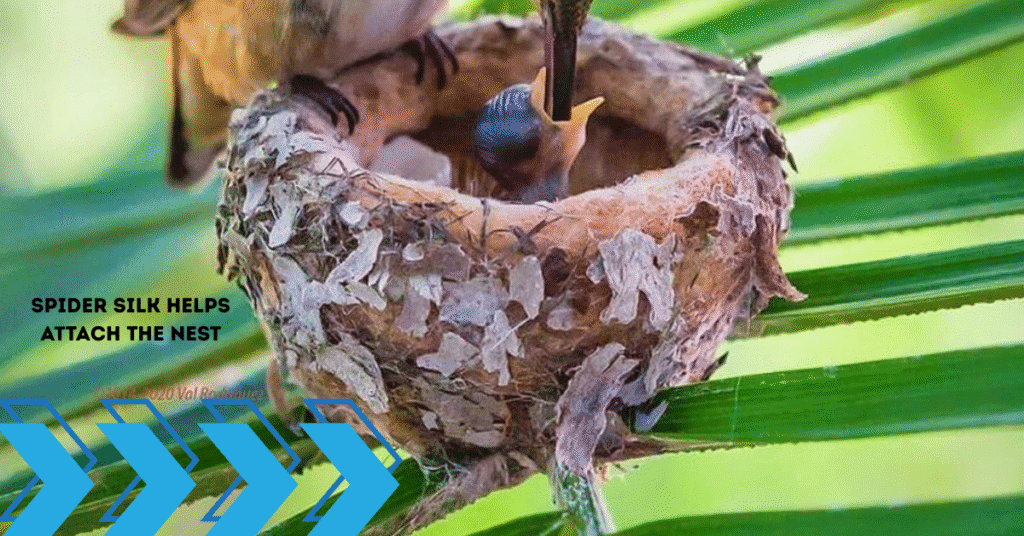
When you watch a hummingbird build her nest, you’ll notice she uses spider silk as a key building material. This silk acts like nature’s stretchy glue.
The spider silk holds the nest together, providing it with remarkable flexibility. As the baby hummingbirds grow bigger inside the nest, the silk stretches to make more room.
You can think of it like a balloon that expands slowly. The nest starts small when the eggs are laid. However, as the chicks develop and require more space, the spider silk enables the walls to stretch outward.
This stretchy quality means the nest doesn’t break apart as it gets bigger. Instead, it grows with the birds inside it.
The silk also helps attach other nest materials, such as lichen and plant fibers. Everything stays connected even as the nest changes shape.
Without spider silk, hummingbird nests would be too rigid. The growing chicks would either break through the walls or become cramped. The silk solves this problem by creating a home that adapts to the birds’ changing needs.
Only the Females Do the Work

Female hummingbirds work completely alone when it comes to nesting. The males don’t help with building or caring for the nest at all.
You’ll find that mother hummingbirds handle every part of the process by themselves. They pick the location, gather materials, and build the entire nest.
These dedicated mothers also take care of their eggs without any help. A mom will sit on the nest to keep the eggs warm and safe.
After the babies hatch, the female continues working alone. She feeds the chicks and protects them from danger.
So much skill and patience is required for the nest-building process. Female hummingbirds use plant fluff, spider webs, and other soft materials to create their tiny homes.
You might wonder why males don’t help. Male hummingbirds focus on finding mates instead of building nests or raising young.
This means every hummingbird nest you see represents the hard work of just one bird. The mother does everything from start to finish to give her babies the best chance at life.
You’ll Likely Never Find One
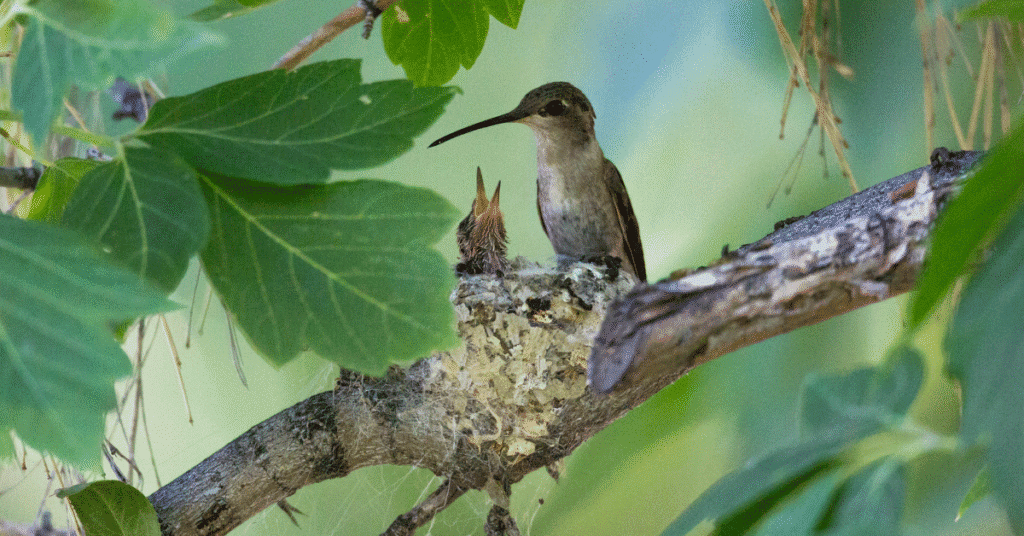
Even experienced birders go years without spotting a hummingbird nest. They’re tiny, well-camouflaged, and often hidden 10 to 40 feet off the ground in deciduous trees or dense shrubs, typically near shaded spots close to nectar sources. A 2011 study published in The Auk noted that researchers had to use pole-mounted cameras and extensive observation hours just to locate a handful of Ruby-throated Hummingbird nests across study sites in the eastern U.S.
Many nests are obscured by leaves, lichen-covered, and built on thin branches that sway in the breeze—making them hard to see and harder to access. Some field biologists have reported that the easiest way to find one is actually to spot the female building it, which requires patience, binoculars, and a good dose of luck. If you do stumble across one, you’re looking at what amounts to a needle in a leafy green haystack.
Nests are reused rarely; They Often Reuse the Same Spot but not Nest
You might think hummingbirds would save time by reusing their old nests. But that’s not how these tiny birds work.
Most hummingbirds build brand new nests for each breeding season. They don’t return to their old homes from the previous year.
Female hummingbirds are the only ones who build nests. They pick fresh spots and start from scratch each time they’re ready to lay eggs.
Sometimes a hummingbird might use materials from an old nest. But the mother bird uses these pieces as the base for building an entirely new nest nearby.
Reusing and recycling happen when the old nest is very close to where she wants to build. The old nest becomes like a foundation for the new one.
You won’t see the same nest used repeatedly, as with some other birds. Hummingbirds prefer fresh construction for their babies.
This means that every breeding season a nest will need to be built! The female spends days gathering materials and shaping her new home before laying her eggs.
Understanding Hummingbird Nest Construction
Hummingbirds create their tiny nests using specific materials and follow a careful building process. Their super detailed construction involves gathering spider webs, plant fibers, and other soft materials to form a cup-shaped home.
Materials Used by Hummingbirds
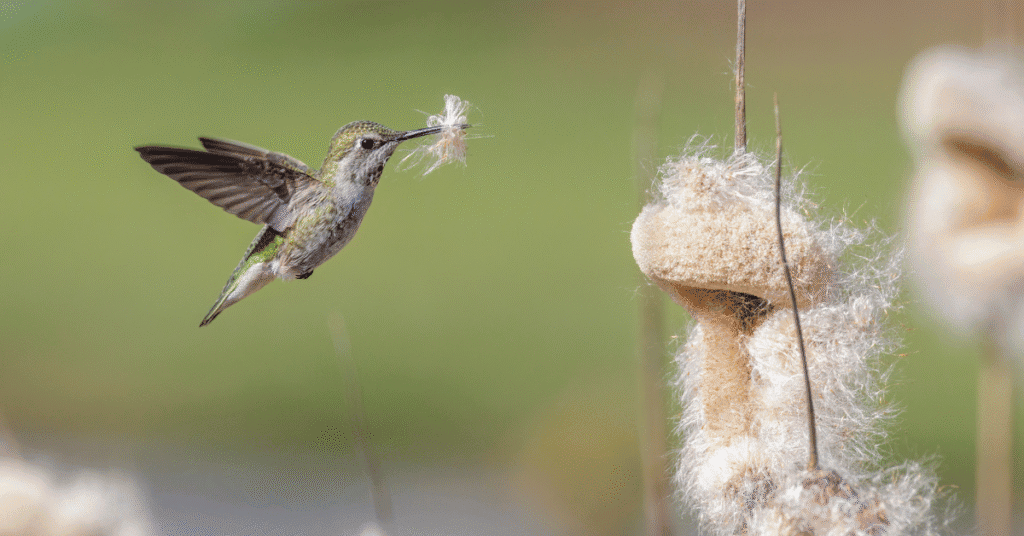
While watching hummingbirds you’ll notice that they are pretty picky about what they use to build their nests. Spider webs serve as the most essential material because they act like glue, holding everything together.
The most common stuff they use is here:
- Spider silk and webs – provide structure and flexibility
- Plant down – soft fibers from dandelions, cattails, and willow trees
- Moss and lichen – cover the outside for camouflage
- Small twigs – create the basic frame
- Animal fur – adds warmth and softness
I’ve also seen Hummingbirds collect cotton, dog fur, feathers, and bits of bark. They prefer materials that stretch as their babies grow. The spider webs are so important that without them, the nest would fall apart.
How Nests Are Built
You can watch a female hummingbird spend 6-10 days building her nest. She works alone and follows the same steps each time.
First, she picks a spot on a thin branch. She uses spider webs to attach the base to the branch. Then she builds up the sides by adding more spider silk and plant materials.
The nest takes shape like a small cup. The hummingbird presses her body into it to make the perfect round shape. After 11 days, the nest is ready for eggs.
She adds the moss and lichen last to hide the nest from predators.
Protection and Placement of Nests
Hummingbirds select nest locations that provide both safety from predators and protection from the weather. Using camouflage and strategic positioning to protect their tiny eggs and babies is a must!
They Do Have Preferred Nesting Locations
You’ll find hummingbird nests in spots that provide shelter and protection. Female hummingbirds prefer to build their nests on thin branches. Plus they’ll usually bend downward under the nest’s weight.
Common nesting spots include:
- Under large leaves or dense foliage
- On branches 10-40 feet above ground
- Near water sources like streams or gardens
- In areas with overhead canopy coverage
When they choose locations where needles, and branches create natural camouflage its for a reason: their survival. Most nests sit directly beneath canopies that shield them from rain and wind.
You can spot nests near flowers (here are some ideas on plants and flowers that attract hummingbirds) and feeders close to the spots where females hunt for food. Since the nests are so small, you may not even notice one right away!
Defense Strategies Against Predators
Female hummingbirds use clever tactics to protect their nests from danger. They build in hidden spots. Some of these include areas within shrubs or thick branched areas. Mainly hoping that predators can’t easily see the eggs and babies.
Key defense methods include:
- Choosing branches that are too thin for larger animals
- Building nests that look like small bumps on branches
- Using materials that match the surrounding bark and leaves
- Positioning nests where overhead cover blocks aerial predators
Male hummingbirds sometimes help by defending territories near nesting areas. They chase away other birds and animals that come too close to their territory.
The tiny size and camouflaged appearance of nests make them nearly impossible for you to spot without careful searching. This natural invisibility is the birds’ best protection against threats.